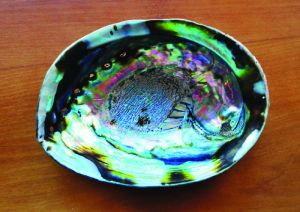|
Few people who have visited New Zealand can have failed to notice paua shells or the artefacts made from them. The paua (pronounced pa-wa or pah-wah) is a large ormer or abalone, Haliotis iris, found all round the coasts of New Zealand, where it is endemic. The best specimens are said to come from the south of South Island and from around Stewart island. This species is also known as the blackfoot paua. There are two other species of Haliotis in New Zealand, the Queen Paua, Haliotis australis, also known as the Silver Paua, Yellow Foot Paua, Hihiwa or Karariwha, and the Virgin Paua, Haliotis virginea, but these are less common and do not appear to be commercially important. A large blackfoot paua can be as much as 6 inches (150 mm) long, and so contains plenty of meat, but it is for the blue-green iridescence of the inside of the shell (Figure 1) that the paua is especially prized (http://en.wikipedia.org/wiki/Paua). According to Maori legend, the paua originally had no shell. Tongaroa, the Maori god of the sea, noticing that this caused problems for the paua, made a covering, using blues from his own ocean, and asking his brother Tane, god of the forest, to add greens; the dawn was to provide violet, and the sunset pink. However, this layer was rather fragile, and so Tangaroa added many more layers to the shell to make it stronger and to camouflage it. The meat is esteemed as a delicacy by the Maori, who serve it on special occasions such as weddings, and the iridescent shell was used to make the eyes on their exquisitely carved wooden figures, and on their canoes. Today, the paua fishery is the fifth largest in new Zealand, worth NZ$ 50 million a year. The meat is eaten not only in New Zealand, but is also exported to Asia, where it is in great demand. Many recipes are available on-line from the New Zealand Abalone Farmers’ Association (http://www.nzafa.org.nz/recipes). The shells are largely made into jewellery (Figure 2), but are also used for a variety of decorative inlaid work, and indeed almost anything you can think of, including ornamenting wedding dresses! To prepare the paua shell for use, the outer layers (which are usually covered with a variety of other marine organisms) are ground away until only the bluegreen nacre remains, and it is this thin layer that is used. This can be done by hand, using progressively finer grades of abrasive paper, but commercially this process is carried out by machines. John Llewellyn-Jones has previously described this industry in detail in an article in these pages (Mollusc World No. 2, pp. 20–21, 2003), to which the reader should refer for more information. Exploitation of paua is controlled by law. The shells can only be obtained by diving without breathing apparatus, and the commercial catch is limited to between 1000 and 1100 tons a year. For recreational fishermen, the number of shells collected must not exceed ten per person per day, although lower limits are applied in some places. Regular assessments are carried out by the Ministry of Fisheries to ensure that the fishery is sustainable (http://www.fish.govt.nz). Needless to say, with such a valuable product, which is easy to catch, unscrupulous criminal gangs break the law and take excessive numbers of paua using artificial aids for diving, and it is estimated that the illegal catch may be as great as the commercial catch of paua. Much of the illegal catch is exported to Asia. From time to time illegal paua fishermen are caught and face fines of up to NZ$ 250,000 and/or 5 years in prison. Recently, sniffer dogs have been trained to detect paua shells, in an attempt to reduce the illegal exploitation of paua. However, New Zealand has a long coastline, much of it remote, and it is difficult to patrol it adequately. To improve the sustainability of the paua fishery, paua farms have been set up. Aquaculture of paua started in the 1980s, and is still on quite a small scale, with only 14 farms operating in 2008, producing 10–15 tons of abalones a year. However, this is expected to rise to 300 tons in the next 10 years or so, making the industry valued at NZ$ 20 million (http://www.nzafa.org.nz). One can only hope that initiatives such as this will counteract the effects of overexploitation, and that future generations will still be able to enjoy this beautiful shellfish. |
Figure 1. The inside of a paua (Haliotis iris) shell from Stewart Island, New Zealand.
Figure 2. Paua shell jewellery.
|
The Paua shell
Issue
19
Page
9


